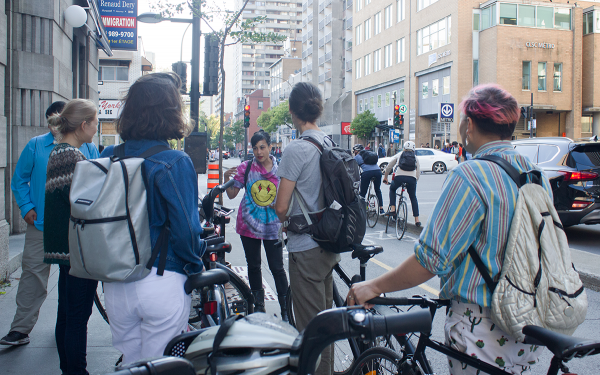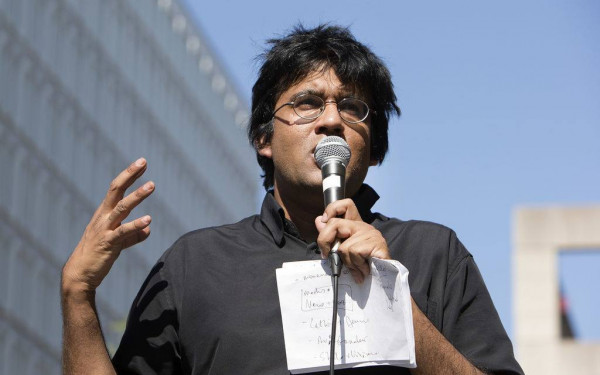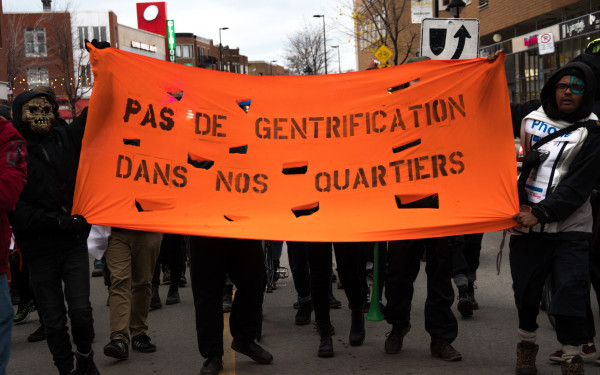“On the Right, You’ll See What Used to Be Affordable Housing”
A Bike Ride Through Montreal’s Gentrified Neighbourhoods
Approaching Concordia’s downtown campus, a group of cyclists waited next to Norman Bethune Square. Ten people were pumping their tires, getting ready to embark on a four-hour journey around the southwest part of Montreal.
QPIRG Concordia, a social justice research group, organized its annual Anti-Gentrification Community Bike tour last Friday, as part of its DisOrientation Week. It aims to educate people and open discussions about class struggles and community initiatives in a few neighbourhoods in the city.
Before the group began moving, members of the crew introduced themselves. Next to a newcomer hoping to discover her new city, long-time residents sought insights on their hometown’s radical history. A visitor, who just arrived in Quebec after a yearlong trip in South America, had only just heard about the event and borrowed a bike to join the ride.
Jaggi Singh, the bike ride’s guide and a staff member of QPIRG Concordia, pointed out key locations of the social justice history of Montreal. Through each neighbourhood, the group delved into past and present stories, which continue to shape the city, to better understand what Singh referred to as “a history of resistance.”
In Shaughnessy Village, a neighbourhood in the western part of downtown, the walls of an old police station continue to attract attention, commemorating the Sex Garage riots. Known as a turning point for the LGBT movement in Montreal, the riots were a response to police brutality at a private party, where participants were beaten and arrested.
Next to Cabot Square, the Montreal Forum, an old hockey-arena-turned-mall and the site of the Maurice Richard riot of 1955, still stands. The suspension of French Canadian hockey player Maurice Richard started the riot, which was considered discrimination against Francophones.
A few streets over, the Overdale squat in an old residential downtown area is still a symbol of the anti-gentrification fight against land developers, who had bought out residences in the area with plans for condos that were never built. Condominium development affects the whole city, changing the landscape and cost of living for working-class families. Throughout Griffintown, massive condos standing alongside old, short buildings illustrate the increasing difficulties of accessing affordable housing.
After snacking on apples at the Atwater market while debating over the responsibility of students and artists in gentrifying the city, the tour continued through the neighbourhood of St. Henri. Les ami(e)s de St. Henri, an association fighting to improve the quality of life of the working-class community, says it empowers people in need, supporting youth and prioritizing food autonomy.
The ride ended in Little Burgundy, known to be an immigrant neighbourhood, where the organization Youth in Motion strives to help its population by educating and supporting them to fight the stigma of living in a low-income area.
Singh emphasized the importance of the tour to preserve the memory of defining social fights and to be aware of the continuing political issues that communities keep facing in Montreal.
“To break the feeling of being always swimming or drowning due to the powers in place in the city, it is important to acknowledge the history of social justice struggles and act on it,” Singh said.

1_900_600_90.jpg)
_600_832_s.png)


1_600_375_90_s_c1.jpg)

